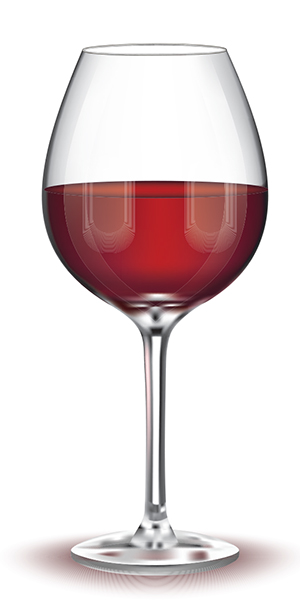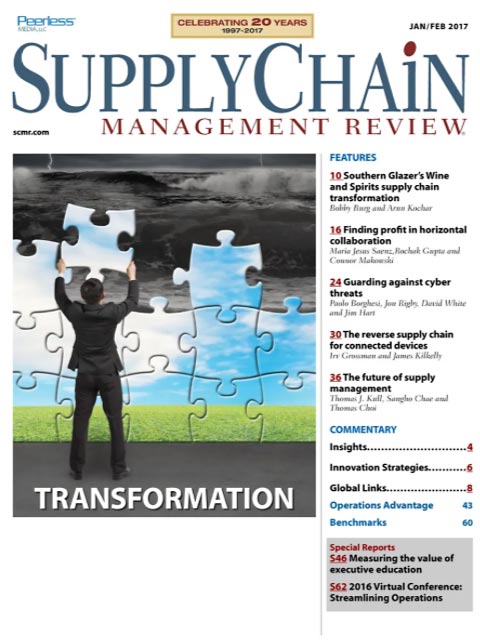Sorry, but your login has failed. Please recheck your login information and resubmit. If your subscription has expired, renew here.
January-February 2017
Transformation is a topic that comes up in almost every conversation I have with supply chain managers these days. Executives from companies as diverse as J&J Vision Care, the division of Johnson & Johnson that manufactures contact lenses, and Thrive Markets, a startup selling health and wellness products to its members, have talked about how they have had to remake their supply chains to meet new customer demands. Transformation is also the theme of this issue of SCMR. Browse this issue archive.Need Help? Contact customer service 847-559-7581 More options
On January 11, 2016, Southern Wine and Spirits agreed to merge with Glazer’s Wine and Spirits and cre¬ate the largest distributor of wine and spirits in North America. The new company, Southern Glazer’s Wine and Spirits, LLC, or Southern Glazer’s, represents more than 2,400 suppliers of wine, spirits, beer and beverages, including more than 5,000 individual brands. The company makes weekly deliveries to approximately 200,000 customers in 44 states, and distributes more than 150 million cases a year to a customer base that ranges from big box retailers and national grocery chains to hotels, retail outlets, and neighborhood restaurants, bars and clubs.
That same month, Bacardi, the world’s largest privately held spirits company, announced that it had selected the newly-formed company to lead the distribution of its wine and spirits portfolio in more than 40 markets across the United States and Canada.
It could be argued that the latter could not have happened without the former: Prior to the merger, it’s doubtful that Southern—or any other single player in the North American wine and spirits industry—would have had the scale and logistics capabilities to create the kind of distribution network Bacardi was looking for.

This complete article is available to subscribers only.
Log in now for full access or start your PLUS+ subscription for instant access.
SC
MR
Sorry, but your login has failed. Please recheck your login information and resubmit. If your subscription has expired, renew here.
January-February 2017
Transformation is a topic that comes up in almost every conversation I have with supply chain managers these days. Executives from companies as diverse as J&J Vision Care, the division of Johnson & Johnson… Browse this issue archive. Access your online digital edition. Download a PDF file of the January-February 2017 issue.
On January 11, 2016, Southern Wine and Spirits agreed to merge with Glazer's Wine and Spirits and cre¬ate the largest distributor of wine and spirits in North America. The new company, Southern Glazer's Wine and Spirits, LLC, or Southern Glazer's, represents more than 2,400 suppliers of wine, spirits, beer and beverages, including more than 5,000 individual brands. The company makes weekly deliveries to approximately 200,000 customers in 44 states, and distributes more than 150 million cases a year to a customer base that ranges from big box retailers and national grocery chains to hotels, retail outlets, and neighborhood restaurants, bars and clubs.
That same month, Bacardi, the world's largest privately held spirits company, announced that it had selected the newly-formed company to lead the distribution of its wine and spirits portfolio in more than 40 markets across the United States and Canada.
It could be argued that the latter could not have happened without the former: Prior to the merger, it's doubtful that Southern—or any other single player in the North American wine and spirits industry—would have had the scale and logistics capabilities to create the kind of distribution network Bacardi was looking for.
SC
MR


Latest Supply Chain News
- Few executives believe their supply chains can respond quickly to disruptions
- Technology’s role in mending supply chain fragility after recent disruptions
- Tech investments bring revenue increases, survey finds
- Survey reveals strategies for addressing supply chain, logistics labor shortages
- Israel, Ukraine aid package to increase pressure on aerospace and defense supply chains
- More News
Latest Podcast

 Explore
Explore
Latest Supply Chain News
- Few executives believe their supply chains can respond quickly to disruptions
- Technology’s role in mending supply chain fragility after recent disruptions
- Tech investments bring revenue increases, survey finds
- Survey reveals strategies for addressing supply chain, logistics labor shortages
- Israel, Ukraine aid package to increase pressure on aerospace and defense supply chains
- How CPG brands can deliver on supplier diversity promises
- More latest news
Latest Resources

Subscribe

Supply Chain Management Review delivers the best industry content.

Editors’ Picks





